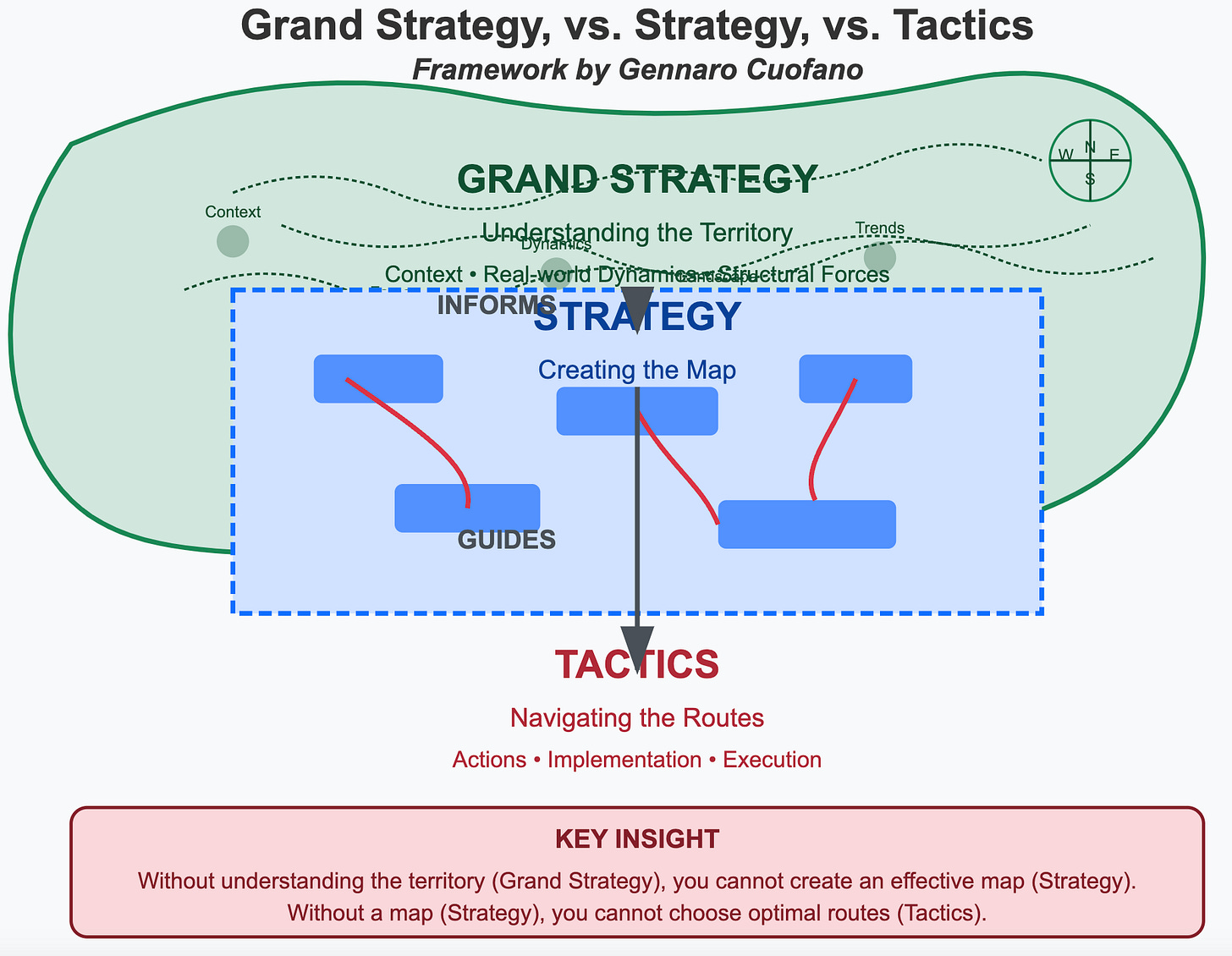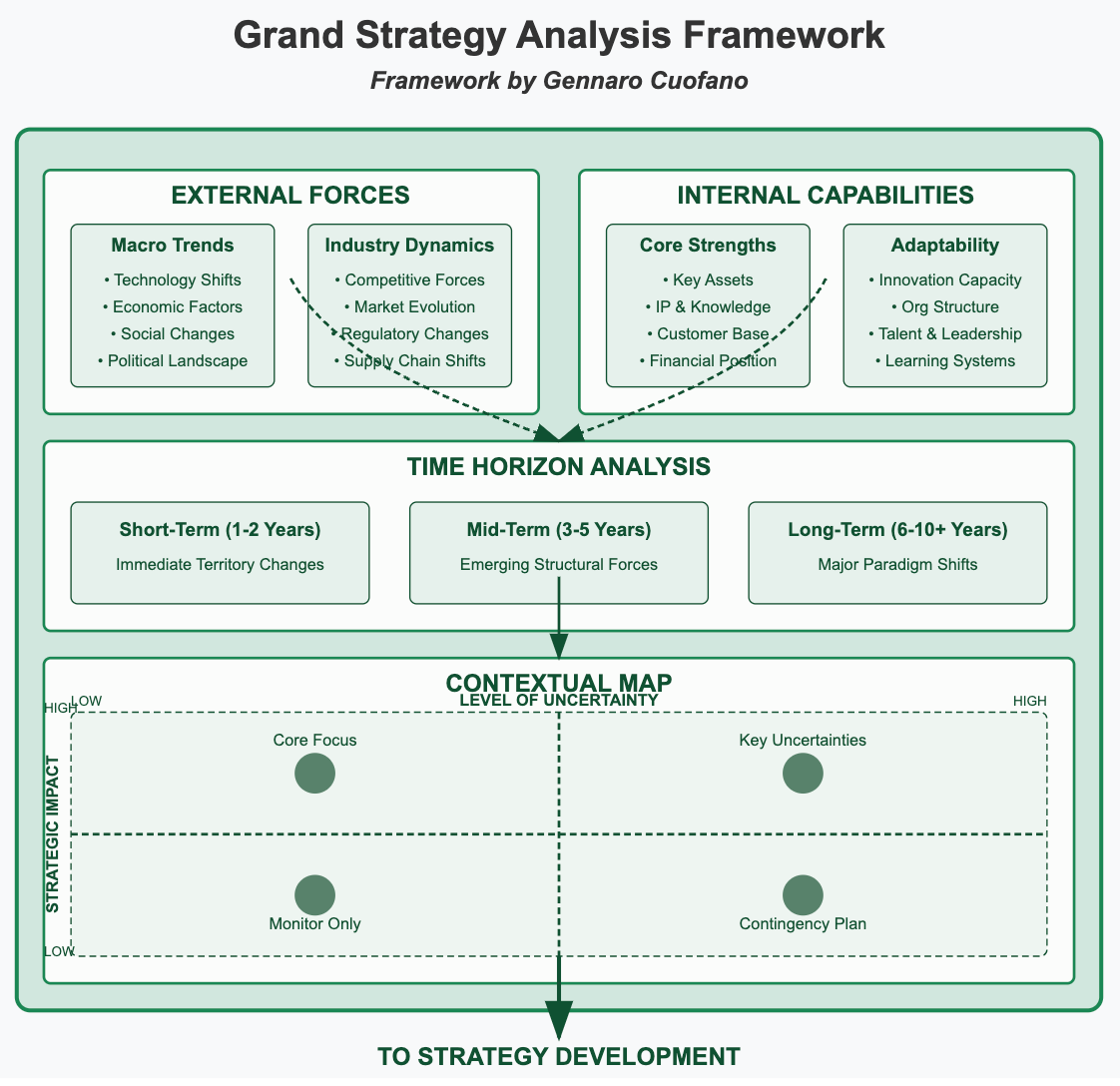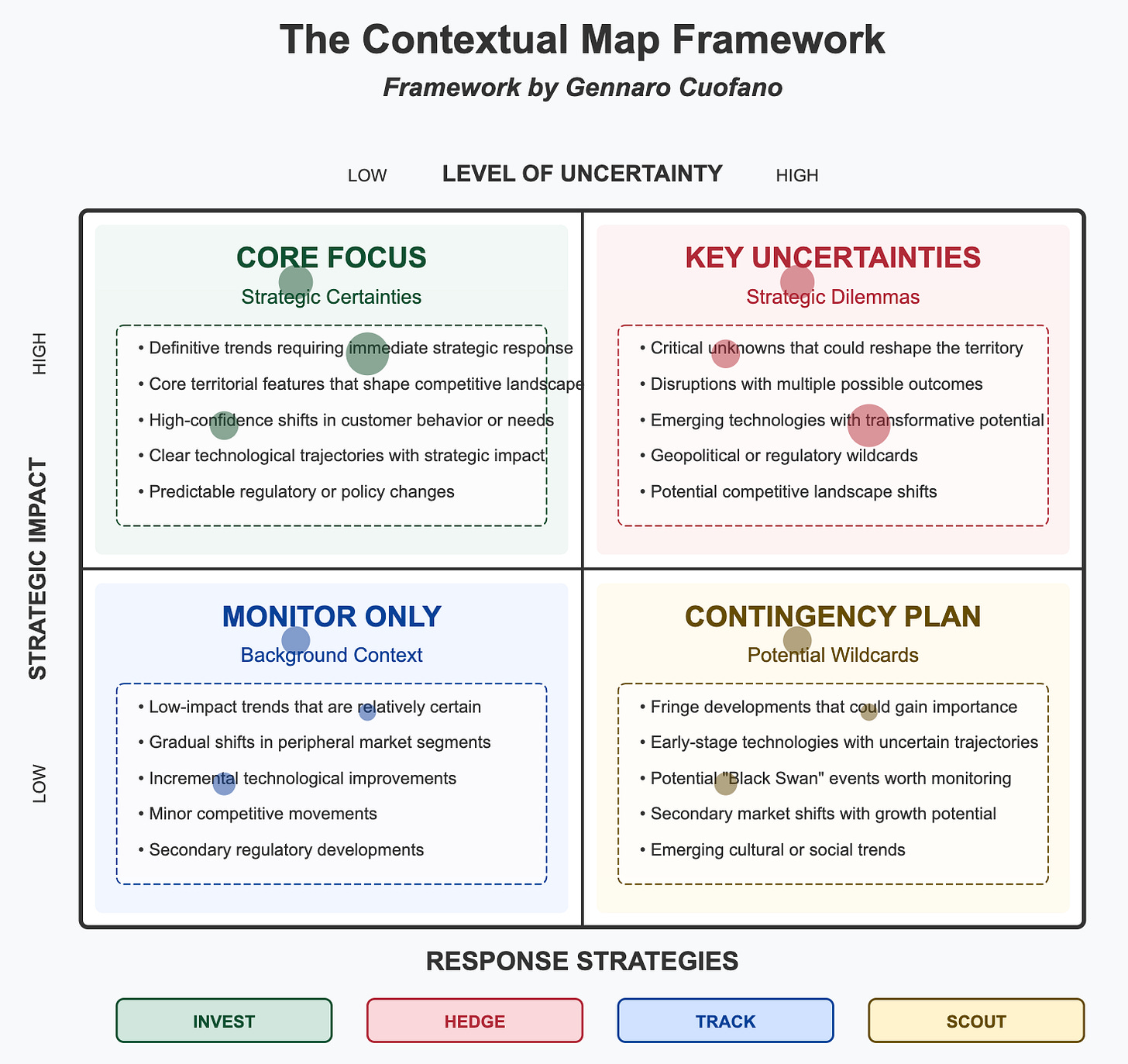Grand Strategy Framework
Understanding the territory is critical in the business world as it helps you discover the “rules of the game” you’re part of.
That’s what grand strategy is for.
I’ve explained that in detail in Grand Strategy.
I can’t stress enough how understanding the underlying structure - underneath your feet - or the existing, developing, changing, shifting context to position yourself in the right place, or at least avoid lethal traps hidden in the territory, is critical and the most valuable skill as a business person.
Again, that’s a Grand Strategy.
You can build your map (strategy) and derive your possible routes (tactics) from there.
Let’s focus on this issue on the grand strategy side.
Where do you begin to define your place in the world?
Explore the reimagined HubSpot Marketplace.
HubSpot's intelligent marketplace uses AI to analyze your business, instantly surfacing the most relevant apps, agents, and partners. Get personalized recommendations that understand your business needs and deliver fast results – without the endless scrolling.
Mapping The Territory
To map out the context, we need to look at:
Contextual Adaptability
External Forces (Understanding the Environment)
Internal Capabilities (Assessing Strengths & Adaptability)
Time Horizon Analysis (Short, Medium, and Long-Term Planning)
Strategic planning must be structured across different timeframes:
Short-Term (1-2 Years): Immediate territory changes, tactical responses.
Mid-Term (3-5 Years): Structural shifts emerging in the market.
Long-Term (6-10+ Years): Major paradigm shifts that require transformational strategies.
Understanding these timeframes ensures strategies are proactive rather than reactive.
Contextual Mapping
Based on strategic impact and level of uncertainty, define the core focus vs. contingency plan.
To build a map (which will change with the territory/context) of where the core focus needs to be and where you need to monitor/have a contingency plan instead.
Contextual Adaptability: How Fit Are You To The Current And Shifting Territory?
External Forces (Understanding the Territory)
External forces shape the opportunities and threats an organization must respond to. These include:
Macro Trends
Technology Shifts: AI, automation, quantum computing, next-gen tech.
Economic Factors: Interest rates, inflation, global trade patterns.
Social & Demographic: Population aging, urbanization, value shifts.
Here, you need to ask:
How could emerging technologies (AI, automation, blockchain) disrupt or enhance our industry?
How do economic factors (inflation, interest rates, trade policies) affect our market?
What social or demographic shifts (urbanization, aging populations, changing values) impact customer behavior?
Why it matters: Companies must anticipate technological disruptions and economic fluctuations to stay ahead.
Industry Dynamics
Competitive Forces: New entrants, substitutes, supplier/buyer power.
Market Evolution: Growth rates, segment shifts, emerging niches.
Industry Structure: Consolidation trends, value chain disruptions.
Here, you need to ask:
Who are our biggest competitors, and how are they evolving?
Are new market segments emerging that we should explore?
How is our industry’s supply chain being disrupted or consolidated?
Why it matters: Understanding market shifts helps companies identify strategic moves (e.g., entering new niches or responding to competition).
Regulatory Environment
Policy Changes: Upcoming legislation, regulatory shifts, compliance.
Geopolitical Factors: Trade tensions, international relations.
Standards Evolution: Industry standards, certification requirements.
Here, you need to ask:
What new laws, compliance rules, or regulations are coming that could impact our operations?
Are there geopolitical risks (trade wars, sanctions, political instability) that could affect our business?
How are industry standards evolving, and do we need to adapt?
Why it matters: Organizations need to stay compliant and adjust to legal shifts to avoid risks and capitalize on new opportunities.
Customer Landscape
Behavior Shifts: Changing preferences, purchasing patterns.
Unmet Needs: Emerging problems, underserved segments.
Decision Journeys: How customers discover, evaluate, and buy.
Here, you need to ask:
How are consumer preferences shifting in our industry?
Are there underserved or emerging customer segments we could target?
How are customers making buying decisions, and how can we influence their journey?
Why it matters: Companies that adapt to changing customer behaviors (e.g., digital buying trends) gain a competitive edge.
Internal Capabilities (Assessing Your Position)
Internal capabilities determine how well an organization can respond to external forces.
Core Assets
Proprietary Technologies: Patents, systems, platforms, processes.
Data & Information: Customer data, market insights, analytics.
Brand & Reputation: Market position, trust, recognition, goodwill.
Here, you need to ask:
What proprietary technologies, patents, or intellectual property give us a competitive edge?
How strong are our data analytics and market intelligence?
Do we have a strong and recognizable brand that builds customer trust?
Why it matters: Strong assets give a company a sustainable competitive advantage.
Resource Base
Financial Capital: Cash reserves, access to funding, capital structure.
Human Capital: Talent pool, expertise, skillsets, leadership.
Operational Infrastructure: Facilities, equipment, supply chain.
Here, you need to ask:
Do we have sufficient financial reserves or access to funding for growth?
Do we have the right talent and leadership to execute our strategy?
Is our operational infrastructure (facilities, equipment, supply chain) scalable and efficient?
Why it matters: Financial strength and talent enable long-term strategic moves.
Organizational Capabilities
Decision-Making: Speed, quality, processes, governance.
Adaptability: Change management, agility, resilience.
Innovation Systems: R&D, experimentation, scaling mechanisms.
Here, you need to ask:
How fast and effectively do we make critical decisions?
How well do we adapt to change—are we agile and resilient?
Are we investing enough in innovation (R&D, experimentation, scaling)?
Why it matters: Agile companies innovate faster and pivot successfully in changing environments.
Strategic Positioning
Differentiation: Unique value proposition, competitive advantages.
Market Position: Share, relationships, channel strength, pricing power.
Strategic Alignment: Purpose, vision, values, culture fit.
Here, you need to ask:
What is our unique value proposition, and how does it differentiate us from competitors?
Are we positioned well in the market (pricing, brand perception, customer relationships)?
Does our company’s culture and leadership align with our long-term strategic vision?
Why it matters: Companies need clear differentiation and strategic alignment to sustain long-term growth.
Time Horizon Analysis: Care About The Immediate, But Beware of The Shifting Horizon
The Time Horizon Analysis Framework provides a structured way to think about strategic planning across different timeframes.
It categorizes decision-making into three horizons: Immediate (0-2 years), Mid-Term (3-5 years), and Long-Term (6+ years). This helps organizations balance short-term actions with long-term vision.
Immediate Horizon (0-2 Years) – Tactical Responses to Current Territory
Focus:
Current competitive dynamics
Ongoing initiatives
Immediate market shifts
Key Question:
What territorial features require immediate response or adaptation?Why It Matters:
This horizon deals with day-to-day operations, short-term market shifts, and tactical moves.
Companies must react quickly to competitive threats, regulatory changes, or economic fluctuations.
Examples: Adjusting pricing strategies, launching new marketing campaigns, optimizing supply chains.
Mid-Term Horizon (3-5 Years) – Strategic Repositioning for Emerging Territory
Focus:
Emerging technologies
Shifting business models
Evolving customer needs
Key Question:
What territorial transformations require strategic repositioning?Why It Matters:
The mid-term horizon is about positioning for future growth and adapting to industry evolution.
Companies must invest in innovation, new markets, and business model adjustments.
Examples: Developing new product lines, expanding into adjacent markets, implementing automation.
Long-Term Horizon (6-10+ Years) – Visionary Exploration of Future Territory
Focus:
Major paradigm shifts
Disruptive forces
Structural industry changes
Key Question:
What entirely new territories might emerge that require reimagination?Why It Matters:
The long-term horizon is about anticipating major shifts and preparing for industry reinvention.
Companies that fail to invest in visionary innovation risk becoming obsolete.
Examples: Investing in AI-driven business models, shifting to renewable energy, and preparing for space exploration.
Multi-Horizon Integration – Balancing Short, Mid, and Long-Term Strategies
Key Insight:
Balance investments across horizons to ensure both survival and evolution.Why It Matters:
Organizations must not overly focus on one horizon at the expense of others.
Short-term survival (tactics) must be balanced with long-term vision (innovation).
Companies that succeed in multi-horizon integration (e.g., Amazon, Tesla, Apple) effectively manage short-term execution while shaping the future.
The Contextual Map: Balancing Strategic Impact With The Level of Uncertainty
The Contextual Map categorizes trends and uncertainties based on strategic impact and level of uncertainty.
It helps organizations determine where to invest, hedge, track, or scout resources effectively.
Core Focus (Strategic Certainties) – Invest
High Impact | Low Uncertainty
What It Represents:
Definitive trends requiring immediate strategic response
Predictable regulatory or policy changes
Clear technological trajectories with strategic impact
High-confidence shifts in customer behavior or needs
Key Question:
What trends are shaping the competitive landscape that we must invest in now?
Response Strategy:
Invest in these areas because they are certain and have a high strategic impact.
Example:
AI-driven automation in customer service or electric vehicle adoption.
Key Uncertainties (Strategic Dilemmas) – Hedge
High Impact | High Uncertainty
What It Represents:
Critical unknowns that could reshape the competitive landscape
Disruptions with multiple possible outcomes
Emerging technologies with transformative potential
Geopolitical or regulatory wildcards
Key Question:
What critical uncertainties could significantly impact our industry, and how can we prepare for multiple scenarios?
Response Strategy:
Hedge by preparing for multiple scenarios and keeping options open.
Example:
Companies investing in both hydrogen and battery-powered electric vehicles as the dominant future technology is uncertain.
Monitor Only (Background Context) – Track
Low Impact | Low Uncertainty
What It Represents:
Low-impact trends that are relatively certain
Gradual shifts in peripheral market segments
Incremental technological improvements
Minor competitive movements
Secondary regulatory developments
Key Question:
Which trends should we track to ensure they do not evolve into major industry shifts?
Response Strategy:
Track these developments but do not allocate major resources.
Example:
A new social media platform with niche adoption but no significant market disruption yet.
Contingency Plan (Potential Wildcards) – Scout
Low Impact | High Uncertainty
What It Represents:
Fringe developments that could gain importance
Early-stage technologies with uncertain trajectories
Potential "Black Swan" events worth monitoring
Secondary market shifts with growth potential
Emerging cultural or social trends
Key Question:
What potential wildcards should we keep an eye on in case they become disruptive?
Response Strategy:
Scout these trends and be prepared to pivot if they gain momentum.
Example:
Quantum computing’s potential impact on cybersecurity has significant potential but an uncertain timeline and feasibility.
Recap: In This Issue!
Understanding the Territory
Grand strategy helps identify structural shifts and avoid risks.
Mapping the territory involves assessing external forces, internal capabilities, and time horizons.
Mapping the Territory
Contextual Adaptability – How well an organization adjusts to change.
External Forces – Identifying opportunities and threats.
Internal Capabilities – Assessing strengths and weaknesses.
Time Horizon Analysis – Balancing short-term and long-term planning.
Assessing External Forces (Opportunities & Threats)
Macro Trends – Technology shifts, economic changes, social and demographic shifts.
Industry Dynamics – Competitive forces, market evolution, industry structure.
Regulatory Environment – Policy changes, geopolitical risks, compliance requirements.
Customer Landscape – Behavior shifts, unmet needs, decision journeys.
Key Questions for External Forces
What technologies or economic trends could disrupt our industry?
Who are our biggest competitors, and how are they evolving?
What regulatory risks or opportunities should we prepare for?
How are consumer preferences shifting in our industry?
Assessing Internal Capabilities (Strengths & Weaknesses)
Core Assets – Proprietary technology, data, brand reputation.
Resource Base – Financial capital, human capital, operational infrastructure.
Organizational Capabilities – Decision-making, adaptability, innovation.
Strategic Positioning – Differentiation, market position, strategic alignment.
Key Questions for Internal Capabilities
What proprietary technologies or assets give us a competitive edge?
Do we have the financial and operational resources to scale?
How quickly can we adapt to market changes?
Is our business aligned with long-term industry needs?
Time Horizon Analysis
Immediate Horizon (0-2 Years) – Tactical responses to competitive dynamics and market shifts.
Mid-Term Horizon (3-5 Years) – Strategic repositioning for emerging trends.
Long-Term Horizon (6-10+ Years) – Visionary planning for disruptive industry shifts.
Key Questions for Time Horizons
What requires immediate response or adaptation?
What industry transformations require strategic repositioning?
What entirely new territories might emerge that require reimagination?
Contextual Mapping: Strategic Impact vs. Uncertainty
Core Focus (High Impact, Low Uncertainty) – Invest in key trends and strategic certainties.
Key Uncertainties (High Impact, High Uncertainty) – Hedge bets on potential disruptions.
Monitor Only (Low Impact, Low Uncertainty) – Track background trends with minor influence.
Contingency Plan (Low Impact, High Uncertainty) – Scout emerging wildcards and risks.
Key Questions for Contextual Mapping
What trends require immediate investment for competitive advantage?
What critical uncertainties could significantly impact our industry?
Which background trends should we track to avoid being blindsided?
What potential wildcards should we monitor for future impact?
Multi-Horizon Integration
Balance short-term actions with long-term innovation to ensure survival and growth.
Successful companies manage both execution and future planning effectively.
Final Takeaway: Understanding the environment, adapting strategically, and balancing risks and investments ensures long-term success.
With massive ♥️ Gennaro Cuofano, The Business Engineer
Explore the reimagined HubSpot Marketplace
HubSpot's intelligent marketplace uses AI to analyze your business, instantly surfacing the most relevant apps, agents, and partners. Get personalized recommendations that understand your business needs and deliver fast results – without the endless scrolling.









